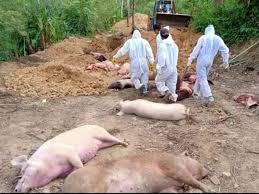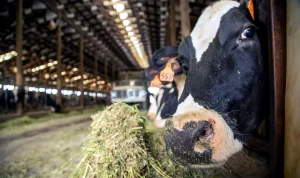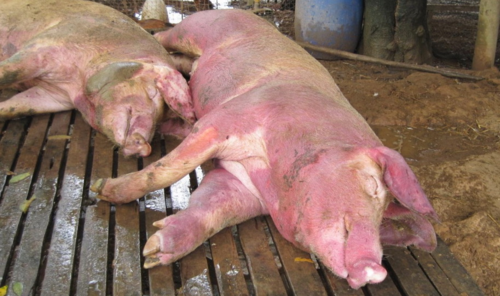Introduction: Dr. Jan-Harm Pol, an esteemed figure in the veterinary realm, brings over three decades of expertise in livestock care. His dedication to animal health and wellness serves as the cornerstone of his invaluable insights into diseases impacting livestock. In this analysis, we navigate the complexities of Classical Swine Fever (CSF) to understand its profound
Introduction:
Dr. Jan-Harm Pol, an esteemed figure in the veterinary realm, brings over three decades of expertise in livestock care. His dedication to animal health and wellness serves as the cornerstone of his invaluable insights into diseases impacting livestock. In this analysis, we navigate the complexities of Classical Swine Fever (CSF) to understand its profound implications on livestock health.
Understanding Classical Swine Fever
Classical Swine Fever (CSF), a highly contagious viral disease affecting pigs, necessitates a nuanced understanding to mitigate its impact on livestock health. Dr. Jan-Harm Pol, a seasoned veterinary expert, provides a comprehensive overview of this disease, shedding light on its origins, transmission dynamics, and potential consequences for swine populations.
- Origin and Transmission: CSF traces its roots to a viral source, with transmission occurring through direct pig-to-pig contact, contaminated feed, and vectors. Understanding these pathways is essential for effective prevention.
- Variability in Impact: Dr. Pol emphasizes the variable danger levels associated with CSF, ranging from mild to severe implications on the overall health and productivity of swine. This insight underscores the importance of tailored intervention strategies based on the severity of the outbreak.

Imageby: https://news.abplive.com/science/african-swine-fever-spreads-in-kerala-know-swine-flu-symptoms-transmission-treatment-1546013
Veterinary Perspective on CSF
Navigating the complexities of Classical Swine Fever (CSF) requires a seasoned guide, and Dr. Jan-Harm Pol provides invaluable insights from his extensive veterinary experience. Drawing upon over three decades in the field, Dr. Pol illuminates the intricate nature of CSF, offering a unique veterinary perspective.
- Diagnostic Challenges: One key aspect highlighted by Dr. Pol is the diagnostic complexity of CSF. Recognizing and differentiating symptoms can be challenging due to their similarity to other swine diseases, demanding a nuanced approach to accurate diagnosis.
- Timely Intervention Significance: Dr. Pol underscores the critical importance of timely veterinary intervention in managing CSF outbreaks. Quick and accurate diagnosis followed by immediate implementation of intervention strategies significantly influences the disease’s course and containment.
Impact on Livestock Health: Assessing the Danger Levels
The repercussions of Classical Swine Fever (CSF) extend far beyond the immediate concerns of infected pigs, necessitating a comprehensive examination of its impact on livestock health. Dr. Jan-Harm Pol emphasizes the varied danger levels associated with CSF, each contributing to the overall well-being and productivity of swine populations.
Varied Health Implications:
CSF exhibits a spectrum of danger levels, from mild symptoms to severe consequences. These implications can include reduced growth rates, reproductive issues, and increased susceptibility to secondary infections, all of which contribute to a compromised overall health status in affected livestock.
Productivity Challenges:
Livestock health isn’t only about immediate well-being but also about sustained productivity. CSF’s impact can disrupt breeding cycles, reduce fertility rates, and lead to higher mortality rates, directly influencing the economic viability of swine farming operations.
Recognizing CSF Symptoms: Early Detection Saves Lives
The key to mitigating the impact of Classical Swine Fever (CSF) lies in the prompt identification of its symptoms, a task made clearer through insights from Dr. Jan-Harm Pol. Early detection not only facilitates rapid response but also plays a pivotal role in preventing the spread of the disease within swine populations.
Fever and Skin Hemorrhages:
Dr. Pol highlights that fever is a prominent early symptom of CSF, accompanied by characteristic skin hemorrhages. Recognizing these visible signs is essential for farmers and veterinarians to initiate immediate investigation and containment measures.
Neurological Signs:
Beyond external symptoms, CSF can manifest through neurological signs such as incoordination and tremors. Dr. Pol emphasizes the importance of closely monitoring swine behavior, as early identification of these signs contributes significantly to the containment of the disease.

Image by: https://www.sageveterinary.com/blog/exploring-meningitis-in-dogs-and-3-ways-to-prevent-it
Safeguarding Strategies: Tips from a Wellness Expert
In the arsenal against Classical Swine Fever (CSF), preventive measures stand as crucial defenses. Dr. Jan-Harm Pol advocates for a proactive approach, emphasizing the importance of comprehensive strategies to safeguard livestock health and prevent the spread of this viral disease.
Vaccination Strategies: Dr. Pol recommends the implementation of effective vaccination protocols as a primary preventive measure against CSF. Regular and timely vaccinations can significantly reduce the risk of infection, providing a robust defense mechanism for swine populations.
Biosecurity Protocols: Acknowledging the potential for CSF transmission through various routes, Dr. Pol underscores the significance of stringent biosecurity measures. Implementing practices such as controlled access, sanitation, and quarantine protocols helps minimize the introduction and spread of the virus within swine herds.
Health Management Systems: Dr. Pol advocates for a holistic health management approach that goes beyond vaccinations and biosecurity. Maintaining optimal herd health through nutrition, sanitation, and routine veterinary care contributes to overall resilience, reducing the susceptibility of swine populations to diseases like CSF.
Economic Ramifications: Effects Beyond Livestock Health
The consequences of Classical Swine Fever (CSF) ripple beyond the immediate health concerns of swine populations, creating a significant impact on the economic landscape of the livestock industry. Dr. Jan-Harm Pol delves into the economic ramifications of CSF outbreaks, shedding light on the broader implications that extend to market stability, trade restrictions, and the financial viability of swine farming operations.
Market Instability: Dr. Pol highlights the potential for CSF outbreaks to cause market instability within the swine industry. Reduced production, fluctuations in supply and demand, and market uncertainties create challenges for both producers and consumers, influencing pricing dynamics and overall market stability.
Trade Restrictions: The international trade of pork and pork products can be severely affected by CSF outbreaks. Dr. Pol emphasizes that the identification of the disease in a region may lead to trade restrictions imposed by other countries to prevent the spread of the virus, impacting global trade relationships and market access.
Global Initiatives: Combatting CSF for a Healthier Livestock Industry
The battle against Classical Swine Fever (CSF) transcends borders, requiring collaborative global initiatives to ensure a healthier and more resilient livestock industry. Dr. Jan-Harm Pol sheds light on the collective efforts and strategies employed internationally to combat CSF, emphasizing the significance of a united front in disease control.
- Collaborative Research and Information Sharing: Dr. Pol underscores the importance of collaborative research endeavors aimed at better understanding the dynamics of CSF. Global initiatives encourage the sharing of information, research findings, and diagnostic tools, fostering a collective knowledge base that aids in more effective disease management.
- Cross-Border Surveillance and Control Measures: To prevent the cross-border spread of CSF, Dr. Pol advocates for synchronized surveillance and control measures. Coordinated efforts in monitoring, early detection, and immediate response mechanisms contribute to containing outbreaks and minimizing the global impact of the disease.

Image by: https://www.darigold.com/the-american-dairy-cow-is-one-of-the-most-efficient-in-the-world-un/
Classical Swine Fever: A Comparative Risk Overview
| Factor | High Risk Areas | Preventive Measures | Vigilance Practices |
|---|---|---|---|
| Transmission Routes | Airborne and Direct Contact | Controlled Transportation | Regular Health Monitoring |
| Global Impact | Widespread Concern | Regional Preparedness Strategies | Collaborative Surveillance Efforts |
| Animal Well-being | Significant Health Risks | Proactive Vaccination Initiatives | Community Involvement for Awareness |
Conclusion:
In conclusion, the analysis of Classical Swine Fever (CSF) led by the expertise of Dr. Jan-Harm Pol provides a comprehensive understanding of the multifaceted challenges posed by this viral disease. From the origins and transmission dynamics to the economic ramifications and global initiatives, each aspect demands attention from stakeholders in the livestock industry. Recognizing the symptoms early, implementing preventive measures, and engaging in global collaborations are imperative steps to safeguard the health and economic viability of swine populations. Dr. Pol’s insights act as a beacon, guiding farmers, veterinarians, and policymakers in navigating the complexities of CSF and fostering a resilient and healthier future for the global livestock industry.





















Leave a Comment
Your email address will not be published. Required fields are marked with *